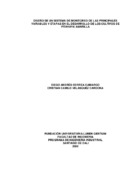Mostrar el registro sencillo del ítem
Diseño de un sistema de monitoreo de las principales variables y etapas en el desarrollo de los cultivos de Pitahaya amarilla
| dc.contributor.advisor | Castañeda Peñaranda, Néstor Mauricio | |
| dc.creator | Correa Camargo, Diego Andrés | |
| dc.creator | Velasquéz Cardona, Cristian Camilo | |
| dc.date.accessioned | 2021-07-16T05:26:33Z | |
| dc.date.available | 2021-07-16T05:26:33Z | |
| dc.date.created | 2020 | |
| dc.identifier.uri | http://hdl.handle.net/20.500.12237/2098 | |
| dc.description | Los agricultores de algunos municipios del Valle del cauca se encuentran produciendo y comenzando a exportar Pitahaya amarilla, fruta exótica apetecida por su sabor, textura y propiedades alimenticias con demanda en el mercado internacional. Sin embargo, debido a que el sector agrícola colombiano es uno de los más rezagados en cuanto a inversión de tecnología y la poca accesibilidad de los agricultores a herramientas guías, de inspección y seguimiento en el cumplimiento de las prácticas agrícolas puede ocasionarles problemas en el manejo de sus cultivos, como ocurrió a finales de los 80´s cuando a nivel nacional por falta de paquetes tecnológicos adecuados y problemas técnicos disminuyo significativamente la rentabilidad y el área de siembra de este cultivo; se hace necesario el desarrollo de un sistema de monitoreo como herramienta informativa para el agricultor en el cumplimiento de las variables y etapas principales que condicionan el desarrollo del cultivo. Es por esto que aplicando una metodología de 3 fases en el presente trabajo, se especifica las etapas y variables principales condicionantes en el desarrollo del cultivo de pitahaya amarilla con base en documentación pública de la Asociación de Productores de Pitahaya – Assopitaya, el Instituto Colombiano de Agricultura – ICA y el Instituto Nicaragüense de Tecnología Agropecuaria – INTA, luego se diseña el sistema de monitoreo compuesto por un manual de bolsillo con la información recolectada de las etapas principales del cultivo, y formatos tanto análogos como automatizados en un libro de Excel, cuyos funcionamientos son validados con ejemplos de usos. | spa |
| dc.description.abstract | Farmers in some municipalities of Valle del Cauca are producing and starting to export yellow Pitahaya, an exotic fruit desired for its flavor, texture and nutritional properties with demand in the international market. However, since the Colombian agricultural sector is one of the most laggards in terms of technology investment and the poor accessibility of farmers to the guide, inspection and monitoring tools in agricultural practices can cause problems in the management of its crops, such as the end of the 80s when the national level due to the lack of affected technological packages and technical problems decreased the profitability and the planting area of this crop; It is necessary to develop a monitoring system as an informative tool for the farmer in the fulfillment of the variables and main stages that conditions the development of the crop. That is why, applying a 3-phase methodology in this work, it specifies the main conditioning processes and variables in the development of the cultivation of yellow pitahaya based on the public documentation of the Association of Producers of Pitahaya - Assopitaya, the Colombian Institute of Agriculture - ICA and the Nicaraguan Institute of Agricultural Technology - INTA, then designed the monitoring system consisting of a pocket manual with the information collected from the main stages of cultivation, and both analog and automated formats in an Excel book, our operations are validated with examples of uses. | spa |
| dc.format.mimetype | application/pdf | spa |
| dc.subject | Sistema de monitoreo | spa |
| dc.title | Diseño de un sistema de monitoreo de las principales variables y etapas en el desarrollo de los cultivos de Pitahaya amarilla | spa |
| dc.subject.subjectenglish | Monitoring system | spa |
| dc.rights.accessRights | info:eu-repo/semantics/openAccess | spa |
| dc.creator.degree | Ingeniero Industrial | spa |

